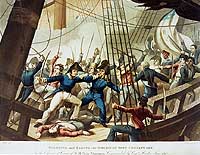Who was Pollard Hopewell?
Pollard
Hopewell, Jr. was the only child of Pollard Hopewell and his wife, Catherine Hebb who
were married December 19, 1785. Pollard, Jr. was born sometime between 1786 and 1789. He
was orphaned at an early age. His father died in 1796 and his mother died on August 5,
1799. Pollard, Jr. was left in the care of his uncle, James Hopewell, [a member of the
Maryland House of Delegates from 1791 to 1809a]. Pollard, Jr. was
appointed 4 June
1812 a midshipman from St. Mary's County, MD. He never married. The story of the incident which makes the name
worthy for naming a ship is as follows.b
The Norfolk-built frigate Chesapeake has been called by one leading
historian an "odd duck". From the refusal of the ship to go down the ways on the
first attempt to launch her to her capture by HMS Shannon in the War of 1812, the frigate
was a hard-luck ship. Given the parsimonious approach to naval expenditures taken by
President James Madison's administration, it is not surprising that the outbreak of war
with England in June of 1812 found Chesapeake in a terrible material state.
The Commandant of the Boston Navy Yard felt she could be ready to cruise by October,
but it was not until 17 December that her new commander, Captain Samuel Evans was able to
get under way. His orders were to patrol the Atlantic between the Cape Verde Islands and
Brazil for British merchant ships. The patrol proved largely uneventful. Chesapeake
returned to Boston on 9 April 1813. On 20 May, Evans was relieved for health reasons by Captain James Lawrence.
Captain Lawrence, thirty-two and newly promoted as a result of his victory over HMS
Peacock while in command of Hornet, did not want the job. His wife was ill, and he pleaded
to be given Constitution instead which would have given him a few more months at home.
Secretary of the Navy, Smith was firm, however, and ordered Lawrence to sea as soon as ready. Off shore
waited the 38-gun frigate, HMS Shannon, under the command of Captain Philip Bowes Vere
Broke. Pollard Hopewell entered the Navy as a Midshipman in June 1812, and reported
to frigate CHESAPEAKE August
21st.
The British frigate SHANNON
overtook their ship on 1 June 1813. He appears to When Chesapeake
passed forward alongside Shannon and the first broadside from Shannon killed
or wounded nearly everyone on the quarterdeck. Of the two men at the wheel, Daniel
Burnham and Jefferson Griffiths, the first fell dead, James Woodbury took his place and
was killed almost immediately and Griffiths was badly wounded by grape shot. James Lewis
tried to control the wheel but fell to the deck wounded and no one took his place. Capt.
Lawrence was struck on the right knee by a pistol ball and fell against the binnacle with
blood pouring down his leg. At the same time the first Lieutenant, Augustus Ludlow, was
hit and badly wounded, Midshipmen John Evans and Courtlandt Livingstone were killed
outright and Lieutenant Broome of the marines and Midshipman Pollard Hopewell were
mortally wounded. The wounded Ludlow was struck by a splinter and brought down leaving no
officers on the upper deck.
At this point Midshipman Cosnahan in Shannon`s maintop hurled down a grenade which
exploded in a box of ammunition on Chesapeake's quarterdeck, killing and wounding more men
and starting a fire which raced over the whole upper deck. The Captain is credited
with the saying, "Don't give up the ship!" The crew was forced to give up the
ship.

Chesapeake was taken to Halifax, Nova Scotia under the command of Capt. Alexander
Gordon, and, after repairs, on to England. She served in the Royal Navy under the command
of Capt. Francis Newcombe, until placed in ordinary (that
is roofed over, and masts removed) in 1816. The ship was sold in 1820 to
a cooper, Mr. Holmes, for £500. He in turn sold Chesapeake's timbers as building material
for houses in Portsmouth, England. Her gun deck timbers were used in the construction of Chesapeake Mill. Which still stands at Wickham
in Hampshire.
This was rebuilt and renamed by John Prior who was a miller, using timber that he
bought in 1820 from the American man-o'-war Chesapeake, a ship captured, as told by the
ballad, by HMS SHANNON in the American War of Independence.2
For more on Chesapeake and
Shannon
a Peter I Oboe, pg 14 Our Navy 9/53
1.
http://userpages.umbc.edu/~pdavis2/Participants/dawsonm/smc/articles_files/nov_pollard.htm
by: Linda Reno, 9/10/2000
2.
http://www.mdarchives.state.md.us/msa/speccol/sc2600/sc2685/house/html/smhouse.html
Edward C. Papenfuse
Public
Records St. Mary's County MD
2.*Michael
Phillips Maritime History Plymouth Naval Base Museum, Joseph C. Mosier, Dana M Wegner, Nile's
Weekly Register Mary Rose
Catalfamo; Manuscripts Librarian Special Collections Nimitz Library United States Naval
Academy, Dictionary of Naval Fighting Ships |